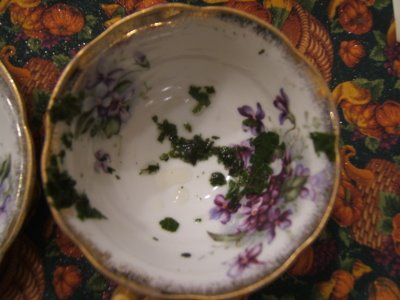
At last night's "Grey School Portland" meeting, Aaran and I practiced tasseomancy, the art of reading tea leaves.
Of course, we had to start by brewing some tea. We used organic herbs from my own garden-- mint and some anise hyssop: 1 tsp. dried herb to 1 C. freshly-boiled water, steeped for 5 minutes.
We had two written guidelines to use, and each was different. So we went through the process a couple of times, and here's what we ended up with.
Tasseomancy: The Aaran-Moonwriter Method
1. Use a real tea cup and saucer--the inside should be completely white (or solid color)-- patterns make it very hard to read the leaf patterns.
2. Measure the amount of water that the cup holds-- most tea cups will hold 4-5 ounces.
3. Brew your tea. Work from a base recipe of 1 tesp. dried herb per cup of freshly boiled water.
 4. For best results, grind the herbs slightly. You don't wnat them powdered, but you also want the leaf mix of a more uniform size, i.e., whole leaves and big chunks will keep the leaves from settlign into patterns as easily.
4. For best results, grind the herbs slightly. You don't wnat them powdered, but you also want the leaf mix of a more uniform size, i.e., whole leaves and big chunks will keep the leaves from settlign into patterns as easily. 5. Measure the herbs into the cup, pour water atop, cover with the saucer, and steep for 5 minutes.
5. Measure the herbs into the cup, pour water atop, cover with the saucer, and steep for 5 minutes.4. When time is up, sit down and drink your tea. As you do, think about the question you wish to have answered in the tea leaves.
5. Drink almost all the water, leaving only enough to create a watery film over the tea leaves.
6. Swirl the tea cup several times with your left hand, while thinkign hard about your question.
7. Put the saucer over the cup. Holding cup and saucer tightly together, flip them over. Do this very quickly.
8. Lift the now-inverted cup off of the saucer and turn it over slowly, so as not to disturb the leaves.
 9. You can now read the leaves in both the cup and the saucer.
9. You can now read the leaves in both the cup and the saucer.10. Use a guide to help interpret obvious symbols (see the Companion for the Apprentice Wizard for a staring guide). But also rely on your own intuition, and on any meanings the caom to you from the leaves. This can be even more valuable that pre-assigned pattern/meaning.
11. According to a compilation of sources:
The tea cup represents information that pertains directly to you and those around you. Patterns near the cup handle or at the point where your lips touched the cup are especially meaningful, while those further from the handle are more distant and less immediately relevant. Patterns closest to the rim relect the present, while those in the cup's bottom foretell the future.
The saucer contains information more relevant to the world or sphere around you.
-----
Here is a snake (generally a symbol of changing luck)in Aaran's cup... and it's near the rim (the present):
 Below is Moonwriter's cup (this is how we learned, the hard way, not to use cups with interior patterns!), showing a horse (or dog?) in the center. The horse appears to leap or gallop toward the viewer's left. Note that just above it is a bird. The horse is a sign of courage and fidelity, while the bird portends good luck.
Below is Moonwriter's cup (this is how we learned, the hard way, not to use cups with interior patterns!), showing a horse (or dog?) in the center. The horse appears to leap or gallop toward the viewer's left. Note that just above it is a bird. The horse is a sign of courage and fidelity, while the bird portends good luck. Fun! Once you've got the hang of this, it would be a terrific-- and easy-- type of personal divination to add to one's day. (And tasty, too!)
Fun! Once you've got the hang of this, it would be a terrific-- and easy-- type of personal divination to add to one's day. (And tasty, too!)Good sites for learning more:
- So you wanna read tea leaves?
- Tea leaf reading-- Tasseography (also mentions coffee ground reading)
- Tea Society of the USA
- Tasseography-- Wikipedia


